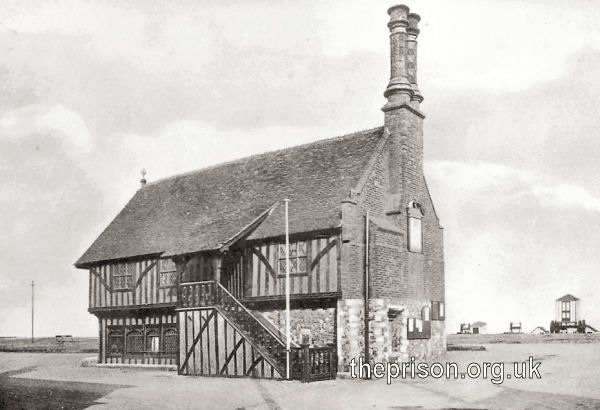Town Gaol, Aldeburgh, Suffolk
Aldeburgh had a Town Gaol underneath its Moot Hall, or town hall, a building dating from around 1550 on what is now Market Cross Place.
In 1812, James Neild wrote:
Gaoler. Francis Osborne, the town coal-meter.
Salary, none. 1805, Sept. 16. No Prisoners.
Two rooms on the ground-floor under the Town-hall; one of nine feet by four feet nine inches; lighted and ventilated by two apertures in the wall, 22 inches by seven: The other 15 feet six inches by eight feet four; lighted and ventilated by two apertures like the former, 18 inches wide by seven; mud floors, with loose straw. No court; no water. Prisoners are seldom confined here more than one night.
By 1835, the Gaol consisted of a single cell, in which disorderly persons were occasionally confined. Prisoners committed for trial or for any lengthened period, were sent to the gaol at Woodbridge.
In 1836, the Inspectors of Prisons gave a dismal report on the prison:
Under the Town Hall, which stands upon the sea beach, and which the sea itself runs through occasionally, at spring tides and in heavy weather, is what is termed the prison of this borough. It consists of a single apartment, 15 feet 8 inches in length, 9 feet in breadth, and 10 feet in height; it is now, by the accumulation of shingle round it, 3 feet below the surface. A breach was made by the sea through the external wall a short time since.
The bailiffs of the borough have the jurisdiction over and the superintendence of the prison. The borough pays its proportion to the county rate, and prisoners are, upon final committal, sent to Woodbridge.
The Corporation pays two sums of 2l. each to the two borough constables, who have the care and sole charge of the prison.
One of the constables states, that not considering it a fit place to detain a prisoner, he kept him, on his own authority, at the White Lion hotel for three days. The longest time he has ever known a man to be in confinement here is a week. He has frequently overlooked acts committed by prisoners, which ought to have been taken notice of, in consequence of not liking to put them in the gaol. A man was confined there one night, about two months ago, for being drunk and rioting in the town. Vagrants are also sometimes lodged there for the night. There is no regular allowance of food for prisoners when confined.
Observations:—This place is happily but seldom used to confine a human, being; it ought never to be so; it is not only unfit and insecure, but absolutely dangerous to life. A suitable lock-up house should be erected at the back part of the town, which is beyond the reach of the sea.

Moot Hall, Aldeburgh, Suffolk, early 1900s.
The prison appears to have continued in use as a lockup but ceased use by about 1850. The building is now home to Aldeburgh Museum and is also used for town council meetings.
Records
- No individual records identified for this establishment — any information welcome.
- The National Archives, Kew, Richmond, Surrey, TW9 4DU. Has a wide variety of crime and prison records going back to the 1770s, including calendars of prisoners, prison registers and criminal registers.
- Find My Past has digitized many of the National Archives' prison records, including prisoner-of-war records, plus a variety of local records including Manchester, York and Plymouth. More information.
- Prison-related records on
Ancestry UK
include Prison Commission Records, 1770-1951
, and local records from London, Swansea, Gloucesterhire and West Yorkshire. More information.
- The Genealogist also has a number of National Archives' prison records. More information.
Bibliography
- Higginbotham, Peter The Prison Cookbook: A History of the English Prison and its Food (2010, The History Press)
- Brodie, A. Behind Bars - The Hidden Architecture of England's Prisons (2000, English Heritage)
- Brodie, A., Croom, J. & Davies, J.O. English Prisons: An Architectural History (2002, English Heritage)
- Harding, C., Hines, B., Ireland, R., Rawlings, P. Imprisonment in England and Wales (1985, Croom Helm)
- McConville, Sean A History of English Prison Administration: Volume I 1750-1877 (1981, Routledge & Kegan Paul)
- Morris, N. and Rothman, D.G. (eds.) The Oxfod History of the Prison (1997, OUP)
- Pugh R.B. Imprisonment in Medieval England (1968, CUP)
Links
- Aldeburgh Museum.
- Prison Oracle - resources those involved in present-day UK prisons.
- GOV.UK - UK Government's information on sentencing, probation and support for families.
Except where indicated, this page () © Peter Higginbotham. Contents may not be reproduced without permission.



